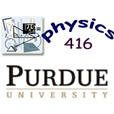
Summary: We define the Gibbs Free Energy, which is the right energy function to use when you can control temperature, pressure, and particle number. This means chemists like it, because chemical reactions in a lab often take place under these conditions. We use this to derive the Law of Mass Action, which shows that the relative concentration of reactants depends only on temperature, and apply this to dissociation of the Hydrogen molecule, water, and hydrochloric acid. We also return to last lecture's discussion of how superconductors repel magnetic fields. Demo: We use liquid nitrogen to cool the high temperature superconductor YBCO below its superconducting transition temperature, so that it is in the superconducting state, and able to levitate magnets. Class discussions: How not to use a refrigerator to cool your apartment; High temperature superconductors and a small part of what's known about them. Lecture Audio
